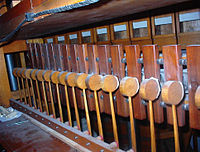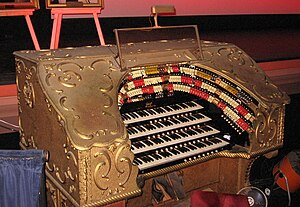Theatre organ
 From Wikipedia - Reading time: 11 min
From Wikipedia - Reading time: 11 min
This article has multiple issues. Please help improve it or discuss these issues on the talk page. (Learn how and when to remove these messages)
|

A theatre organ (also known as a theater organ, or, especially in the United Kingdom, a cinema organ) is a type of pipe organ developed to accompany silent films from the 1900s to the 1920s.

Theatre organs have horseshoe-shaped arrangements of stop tabs (tongue-shaped switches) above and around the instrument's keyboards on their consoles. Theatre organ consoles were typically decorated with brightly colored stop tabs, with built-in console lighting. Organs in the UK had a common feature: large translucent surrounds extending from both sides of the console, with internal colored lighting. Theatre organs began to be installed in other venues, such as civic auditoriums, sports arenas, private residences, and churches.
There were over 7,000 such organs installed in America and elsewhere from 1915 to 1933, but fewer than 40 instruments remain in their original venues.[1][failed verification] Though there are few original instruments, hundreds of theatre pipe organs are installed in public venues throughout the world today,[2] while many more exist in private residences.
History
[edit]Originally, films were accompanied by pit orchestras in larger houses, and pit pianists in small venues. The first organs installed in theatres were church organs. These organs were ill-suited to accompanying the film and the performance.
The earliest concepts of the theatre organ were modified pianos with a few ranks of pipes and various sound effects, housed in one cabinet, and typically located in the pit area. These were photoplayers.
Robert Hope-Jones's concept, which he called a "unit orchestra", was developed and promoted, initially by the Rudolph Wurlitzer Company of North Tonawanda, New York. A new type of instrument, the Wurlitzer Hope Jones Unit-Orchestra, or simply theatre organ, was born. Soon, hundreds of instruments were being ordered from Wurlitzer and other manufacturers who copied the design for their own theatre organs.
The Rudolph Wurlitzer company, to whom Robert Hope-Jones licensed his name and patents, was the most well-known manufacturer of theatre organs, and the phrase Mighty Wurlitzer became an almost generic term for the theatre organ. After some major disagreements with the Wurlitzer management, Robert Hope-Jones committed suicide in 1914.
In Europe, the theatre organ appeared in cinemas after World War I. Some came from Wurlitzer, but there were European organ builders like M. Welte & Söhne and Walcker in Germany, and Standaart in the Netherlands.
After the development of sound movies, theatre organs remained installed in many theatres to provide live music between features. After the "golden years" of the 1920s and 1930s, many were scrapped or sold to churches, private homes, museums, ice rinks, rollatoriums, and restaurants.
The British Broadcasting Corporation bought and installed its first organ in 1933 in Broadcasting House, London. The first full-scale BBC Theatre Organ was used for broadcasts in 1936 from across the road at St George's Hall.[3]
In the 1950s, the development of high-fidelity recording and the LP phonograph record created new interest in the theatre organ. This period also saw the formation of the American Theatre Organ Society (ATOS), originally the American Theatre Organ Enthusiasts (ATOE).
Manufacturers and production totals
[edit]
These were the major builders of theatre organs, listed in order of production. The numbers listed here are for theatre organs only.
| Manufacturer[4] | Production[4] | Timeframe |
|---|---|---|
| Wurlitzer | over 2,234 | 1911-1942 |
| Robert Morton | about 900 | 1920s-1931 |
| Möller | about 700 | |
| Kimball | about 700 | |
| Marr and Colton | 500-600 | 1915-1932 |
| Barton | 250-350 | 1918-1931 |
| Kilgen | 200-300 | |
| Robert Hope-Jones | 246 | 1887-1911, sold to Wurlitzer. |
| Hillgreen-Lane | about 175 | |
| Estey | about 170 | |
| Austin | about 130 | |
| Link | about 130 | 1914-1932 |
| Page | over 100 | 1922-1930 |
| Balcom and Vaughan | about 75 | |
| Reuter | about 57 | |
| Hill, Norman & Beard (Christie) | >52[5][6][7][8] | 1926-1938 |
| Midmer-Losh | about 50 | |
| Compton | ||
| Geneva | ||
| Welte-Mignon | ||
| Wicks |
Technical aspects
[edit]
As in a traditional pipe organ, a theatre organ uses pressurized air to produce musical tones. Unification and extension give the theatre organ its unique flexibility. A rank is extended by adding pipes above and below the original pitch, allowing the organist to play that rank at various pitches by selecting separate stop tabs.

The electro-pneumatic action was invented by Robert Hope-Jones. Up to the turn of the 20th century, all pipe organs were operated by a tracker, tubular pneumatic, or pneumatic Barker-lever action, where the keys and pedals were physically connected to the pipe valves via wooden trackers, except in the case of tubular pneumatic, where all actions were operated by air pressure. Hope-Jones' electro-pneumatic action used electric solenoids to operate the pipe valves, and solenoids and pistons to control and operate the various stop tabs, controls, keys and pedals on the console. This action allowed the console to be physically detached from the organ. All signals from the console were transmitted by an electric cable to an electro-pneumatic relay, and from there to the pipes and effects in the organ chambers.[9]

Another feature of theatre organs is the addition of chromatic, or tuned percussions. Hope-Jones added pneumatically and electrically operated instruments such as xylophones, wood harps, chimes, sleigh bells, chrysoglotts and glockenspiels to reproduce the orchestral versions of these instruments.
Wurlitzer added other effects, such as drums, cymbals, wood blocks and other non-chromatic percussions and effects to allow the theatre organ to accompany silent movies.[10] Examples of sound effects included car horns and flings.
A traditional organ console was not adequate to control a theatre organ, as the large number of draw knobs required made the console so huge an organist could not possibly reach all of them while playing. Thus, the horseshoe console was born. Based on a curved French console design and using stop tabs instead of drawknobs, the horseshoe console now allowed the organist to reach any stop or control while playing any piece of music, eliminating the need to move around awkwardly on the bench. The smaller stop tabs also permitted the addition of many more stops on the console than could be added on a traditional console.
New and old organs
[edit]
So-called "new" organs have been recently built, mainly from parts of other theatre organs, with construction of new pipework, windchests and consoles.
Some of these refurbished organs have had their original electro-pneumatic relays replaced with electronic or computerized relays and modern, electronic consoles.
See also
[edit]- Capri Theatre, home of Australia's second largest theatre organ
- Photoplayer, an automatic piano and orchestra used by smaller theatres to accompany silent films
- Winter Gardens, Blackpool
- Wurlitzers in the United Kingdom
Footnotes
[edit]- ^ Steven Ball. The Story of The Hollywood Barton."Steven Ball". Archived from the original on 2012-02-08. Retrieved 2013-08-23. Journal of the American Theatre Organ Society (November/December), citing The Hollywood Theatre, Detroit, MI Detroit News March 17, 1963.
- ^ "Theatre Organ Locator". American Theatre Organ Society.
- ^ Leslie Spurling. 'The Organ of the Future', Radio Times, Issue 681, 18th Oct 1936, pp. 8 and 42
- ^ a b "Searchable Opus Database". barton.theatreorgans.com. Retrieved November 4, 2013.
- ^ "UK organs". The Cinema Organ Society. Retrieved 27 October 2015
- ^ IanM. "List of All Known Australian Theatre Organs - Past and Present". theatreorgans.com. Retrieved 27 October 2015
- ^ cinematreasures.org. "Gaumont Palace in Paris". Retrieved 27 October 2015
- ^ Bush, Douglas Earl; Kassel, Richard, eds. (2006). The Organ: An Encyclopedia. Psychology Press. p. 253.
- ^ The earliest unit orchestras utilized a separate wind supply to the console to operate combination pistons, which at that time were pneumatically operated. Later designs electrified the combination action, eliminating the need for the console wind supply.
- ^ Various builders of church organs, notably Möller, Austin, Aeolian-Skinner and Kimball, added a limited number of chromatic percussions to their church instruments.
External links
[edit]- The Beer Wurlitzer - Oldest Wurlitzer theatre organ in the UK
- American Theatre Organ Society
- Cinema Organ Society (UK)
- The Theatre Organ Home Page
- Theatre Organs UK
- The Wurlitzer Opus List
- The Compton List by Ivor Buckingham (1945–2008)
- Scottish Theatre Organ Preservation Society
- Saenger Theatre Organ/Pensacola restoration project
- Theatre Organ Society of Australia
 KSF
KSF